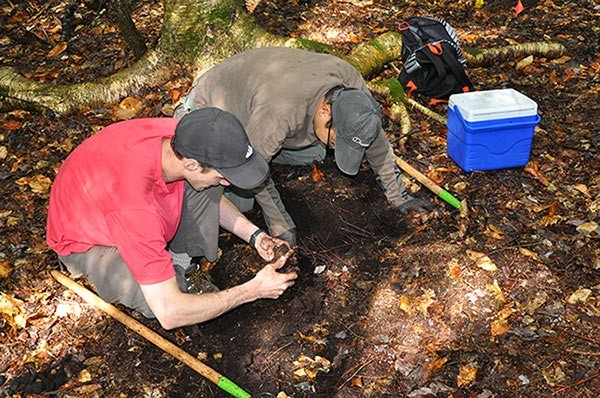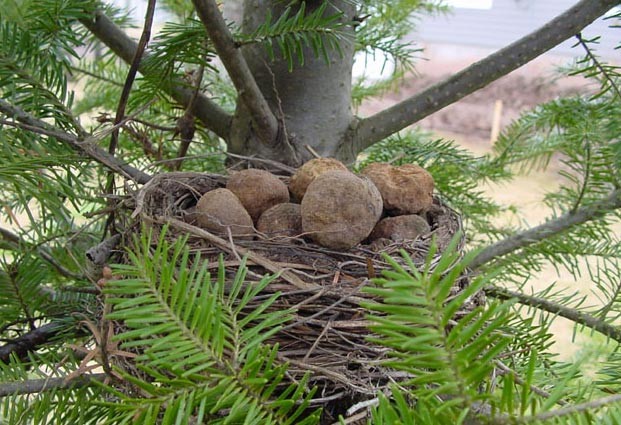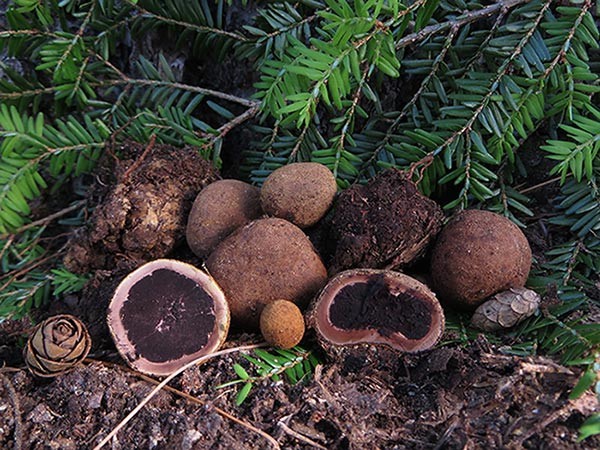While on an afternoon hike last fall, I sat down at the base of a large tree to take in what might be going unnoticed. Within seconds, a chipmunk appeared from behind a pile of large rocks. Based on its behavior, I suspected this chipmunk had had the good fortune of a past encounter with a hiker willing to share a snack. When it realized that I had nothing to offer, the chipmunk turned and began searching the area. It quickly stopped and began digging. Lucky guy, I thought, assuming that the chipmunk had located a cached acorn buried by a hard-working gray squirrel. It came as a surprise, then, when in less than a minute, the chipmunk unearthed an acorn-sized truffle!
Most of us have heard of truffles, though we often associate them with fancy European restaurants; black and white truffles, in particular, are prized ingredients. But truffles exist here, as well, and while our Northeastern chipmunks probably don’t have gourmet tastes, they’re certainly gourmand in their taste for truffles.
Truffle terminology
A wide variety of fungi are found in most forests, and loosely speaking, they obtain nutrients in one of three ways. Saprotrophic fungi are decomposers. They release acids and enzymes that break down dead tissue into smaller molecules that they can absorb. Decaying wood, plants, and even some animals can become food for a saprotroph. Examples of these include oyster and shiitaki mushrooms. Parasitic fungi infect a living host and sometimes kill it. The distinction between parasitic and saprotrophic fungi isn’t always clear; for example, some bracket fungi that produce conks on the exterior of a tree trunk can be both. Mycorrhizal fungi form symbiotic relationships with the root systems of forest plants. Common examples include porcini, chanterelle mushrooms, and almost all truffles.
The fungal “mycelium” – a mass of branching, thread-like fibers – encapsulate the roots of a tree and extend out into the soil where they capture water, nitrogen, phosphorus, and other nutrients that are then transported to the tree’s roots. In return, the mycelium fibers obtain carbohydrates (sugars) from the roots. A number of field and laboratory experiments have demonstrated that removing the fungus substantially reduces the growth rate of a tree and can result in its death. So, healthy trees need their fungi and fungi need their trees.
The term “truffle” is commonly used in reference to the belowground fruiting body, or sporocarp, that enables reproduction. An above-ground mushroom’s fruiting body grows up and out of the ground on a stem and then develops a cap that contains spores. Once the cap dries out, it releases the spores into the wind as a means of reproduction. But because truffles fruit in the soil, this wind-blown spore dispersal mechanism isn’t possible. The truffles’ cap has evolved into an underground mass that resembles a small potato; within that mass are millions of spores and each can develop into a new truffle-bearing fungus. So, how do truffle spores disperse if they are below ground?
It’s important to be eaten
Let’s return to the chipmunk I encountered on my hike. As it handled what seemed to be a stag or deer truffle (genus Elaphomyces), the chipmunk seemed most intent on eating the outer rind, or peridium. No doubt it also swallowed a number of spores found inside. In addition to chipmunks, flying squirrels, red squirrels, various voles and mice, deer, bears, and even fishers are known to consume truffles. Truffles provide these animals with nutrients, essential minerals, amino acids, and vitamins. Vitamin D in some truffles occurs in higher concentrations than most other foods available in the forest, and for nocturnal rodents, truffles may be an important source of this “sunshine vitamin.”
In New Brunswick, Canada, red squirrels and northern flying squirrels are major truffle consumers. Truffle researcher Karl Vernes found that red squirrels cache truffles as they do spruce cones, often in a central location or midden. Near the town of Moncton, for example, a suburban red squirrel was found to be using an abandoned robin’s nest to store more than 50 deer truffles. Truffles preserve well simply by air drying, so having a cupboard well stocked with truffles is a wise strategy for a snowbound squirrel.
Similar to berry-eating birds, chipmunks and other animals that eat truffles disperse the undigested spores, helping to establish new populations of the fungus. Additionally, researchers found that fungal spores collected from flying squirrel droppings had a higher germination rate than spores collected directly from the truffle. This suggests that, in addition to aiding in spore dispersal, the success of spores may be enhanced by passing through the digestive tract where they are exposed to body heat and digestive enzymes. Or it may simply be that fungal spores deposited in droppings have a readily available supply of fertilizer.
How do animals locate a buried truffle? Above-ground fruits signal to animals that they are ready to be eaten by changing color; truffles also signal to their consumers, but do it with a distinct odor. As truffles mature, they produce strong, chemically complex odors that attract many small mammals. The scent of a truffle may contain compounds similar to certain animal pheromones, meaning that a little goes a long way. And like pheromones, they are often species-specific. The truffles I’ve handled range from mildly foul, like something rotting, to a very pleasant citrus-like odor. Responding to these olfactory cues, small mammals are adept at uncovering mature fruit-bodies of truffle fungi. This clue to finding truffles has also been used by human foragers seeking prized white and black truffles in southern Europe. Historically, human- truffle-hunters relied on the sensitive snout of a domestic pig that was tethered on a leash. Pigs are efficient in rooting out truffles; however, a major downside to this approach is that they often eat the truffles before their handler can scoop them up. As a result, dogs have replaced pigs because they are more interested in a treat as a reward than eating the truffles they sniff out.
How widespread is the truffle connection?
In their comprehensive book Trees, Truffles, and Beasts – How Forests Function, authors Chris Maser, Andrew Claridge, and James Trappe summarize decades of their research on truffles in the Pacific Northwest and Australia. They trace the long evolutionary history of truffles and show that the relationships among trees, fungus, and fungus-eating (mycophagous) animals have existed for a very long time and likely occur throughout the forests of the world.
In northern Minnesota, forest ecologists John Terwilliger and John Pastor were puzzled as to why black spruce trees were rare in abandoned, drained beaver meadows, yet very common in surrounding forests. Using information on the diet and distribution patterns of red-backed voles, a major consumer of truffles in that region, these researchers were able to demonstrate that it was the reluctance of voles to enter the meadows and the lack of their spore-filled droppings that limited black spruce from colonizing the meadows. Fungal spores and the mycorrhizal network that eventually develops are essential for seedling spruces to thrive.
In New England, the role of truffles in forest ecosystems had largely gone unexamined until researchers from the University of New Hampshire recently took on the topic. Associate Professor Rebecca Rowe and doctoral student Ryan Stephens are leading the investigation in the White Mountain National Forest. Among the questions they are addressing: What conditions affect the distribution and abundance of truffles in northern forests?
Although fundamental to our knowledge of forest ecology, such information can also aid in understanding how disturbances, natural or human-caused, can affect mycorrhizal fungi, thereby aiding in the development of approaches that might help offset such disruptions to this co-dependent system. To answer this question, Stephens and Rowe inventoried the abundance and variety of truffles in different parts of the forest, divided by dominant tree groupings. Hardwood stands included American beech, red maple, sugar maple, yellow birch, white birch, and white ash. Softwood stands were dominated by eastern hemlock, red spruce, balsam fir, and an occasional white pine. Finally, mixed-wood stands included a combination of both hardwoods and softwoods. Within each forest type, Stephens and his field assistants used garden cultivators to rake up samples of the forest floor and then carefully filtered through the rotting leaves, needles, branches, and soil in search of truffles.
Suspecting that this method might miss some truffles, Stephens also used chipmunks as an additional source of information. Small, baited box traps were set to capture chipmunks in the same forest stands that were sampled by digging. When captured, small mammals usually defecate in the trap. So it’s quite easy to get several samples from an animal and then release it. The more challenging part of this approach is identifying the specific truffles eaten by chipmunks from the fungal spores found in their droppings. Size and shape of spores are often unique for a variety of truffle, and there are standardized keys that lead a biologist to a correct identification. But spores are quite small – some just a fraction of the width of a human hair – and as a result, extreme care and the use of a powerful microscope is required when preparing and identifying samples.
While the research is not yet complete, Stephens and his colleagues have found some interesting patterns. Truffles were most abundant in softwood stands, with an average of roughly 60 pounds growing per acre, and least abundant in hardwoods, with less than 7 pounds per acre. Not surprisingly, chipmunk droppings yielded a greater variety of truffles than the researchers were able to locate on their own. Chipmunks are capable of finding truffles that are no larger than a plump grain of rice.
Among individual trees, eastern hemlocks were consistently associated with sites containing the most truffles. Even in hardwood stands, clusters of truffles were located at the base of a lone hemlock. This pattern suggests a tight relationship between hemlocks and several of the most common truffles that Stephens found in the White Mountains. That relationship makes sense because hemlocks are abundant in northern forests and they are among the longest-lived trees, which must be an attractive trait to a symbiotic fungi.
The human connection
The researchers also found that the vitality of truffle-producing fungi is clearly linked to its host trees. When trees are removed or the composition of a forest changes over time, the diversity and abundance of truffles in the forest will also change. As a result, wildfires and timber harvests can have a large effect on truffles. Removal of host trees eliminates the supply of energy to the fungus and that prevents it from producing truffles. In addition to removing host trees, soil temperature, moisture content, and compaction can limit truffles. Based on that information, foresters and loggers might be encouraged to leave small groups of trees that include at least one dominant tree to ensure that important fungi remain on a site where most trees are removed. In northern New England, it may be especially appropriate to leave groups of hemlock.
The association of truffles with eastern hemlocks raises greater concerns because of the recent invasion into the Northeast of the hemlock woolly adelgid, an insect that threatens the hemlock’s very existence. At the Harvard Forest in western Massachusetts, forest ecologists are attempting to understand the changes that will occur to forest composition if hemlocks die out. Using experimental removals (where hemlocks are cut) and computer simulations, they predict that white pine, black birch, and beech trees may become more abundant. Their results also indicate that changes in forest composition will vary with local conditions, such as soil fertility and rainfall patterns. Regardless of which species replace them, there’s no doubt that with a loss of hemlocks, the diversity and perhaps abundance of truffles will change.
Understanding the role of small mammals and truffles in maintaining the vitality of our forests highlights the interdependence of organisms and how those connections may be disrupted. Chipmunks and truffles may be small, but it is quite impressive to see how important they are to a healthy forest.










Discussion *